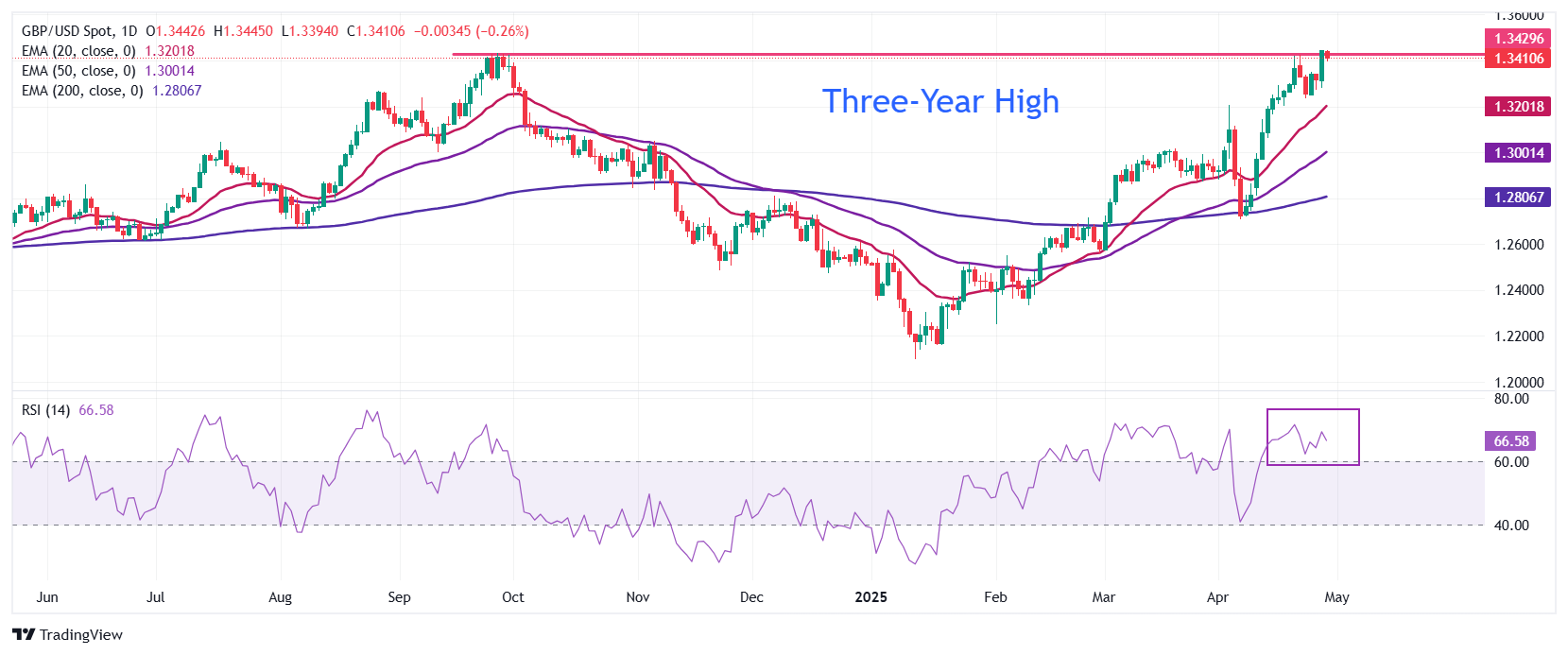-
Pound Sterling slips against the US Dollar, approaching the 1.3400 level ahead of key US economic releases, including the Q1 GDP report.
-
The US economy is projected to have grown modestly by 0.4% during the first quarter.
-
BoE’s Greene views Trump’s tariff strategy as having a net disinflationary impact on the economy.
The Pound Sterling (GBP) underperforms most major currencies—except the Japanese Yen (JPY)—during Wednesday’s European session, as market expectations grow for a 25 basis point (bps) rate cut by the Bank of England (BoE) at its May 8 policy meeting. The shift in sentiment comes amid mounting fears that the US’s new tariff policy will ease inflationary pressures and dampen UK economic growth.
BoE policymaker Megan Greene, speaking at the Atlantic Council on Friday, described the potential trade war as “net disinflationary” for the UK economy. She also expressed concern about possible labor market disruptions following an increase in employer contributions to national insurance—from 13.8% to 15%—which took effect this month.
Adding to the dovish tone, BoE Governor Andrew Bailey highlighted the risk posed by escalating trade tensions. Speaking on the sidelines of the IMF Spring Meetings in Washington, Bailey stated, “We do have to take very seriously the risk to growth.”
With no significant domestic data on the UK economic calendar this week, external developments remain the key drivers for GBP price action.
Despite a softer performance against most currencies, the Pound has held relatively steady versus the US Dollar, supported by continued uncertainty surrounding the US-China trade standoff. The US has called on China to re-engage in talks, citing the imbalance in trade. “I believe it’s up to China to de-escalate, because they sell five times more to us than we sell to them,” said Bessent in an interview with CNBC’s Squawk Box on Monday. Meanwhile, China has reiterated its commitment to defending its economic interests and national dignity in response to rising tensions.
Daily Digest Market Movers: Pound Sterling Pulls Back Ahead of Key U.S. Economic Data
- The Pound Sterling (GBP) edges lower against the U.S. Dollar (USD), trading near the 1.3400 level during Wednesday’s European session after hitting a fresh three-year high of 1.3445 on Tuesday. The modest retreat in the GBP/USD pair reflects a slight rebound in the U.S. Dollar as investors await a series of high-impact U.S. economic reports, with the spotlight on the preliminary Q1 Gross Domestic Product (GDP) figures.
- The U.S. Bureau of Economic Analysis (BEA) is forecast to show that the economy grew at an annualized pace of just 0.4% in the first quarter—down sharply from 2.4% in the previous quarter. This anticipated slowdown reflects concerns that the sweeping tariffs introduced by President Donald Trump earlier this month may be weighing on economic activity. While the protectionist measures were intended to stimulate domestic manufacturing by curbing imports, ongoing uncertainty surrounding trade policy has led many businesses to delay expansion plans.
- In addition to GDP, markets are closely watching other key data releases, including the Q1 Employment Cost Index, April’s ADP Employment Change, and the March Personal Consumption Expenditures (PCE) Price Index—the Federal Reserve’s preferred inflation measure.
- The Employment Cost Index is projected to show a 0.9% increase, indicating steady wage growth. Meanwhile, private sector job creation is expected to slow, with only 108,000 new jobs in April compared to 155,000 in March. Core PCE inflation is also expected to ease, with an annualized growth rate of 2.6%, down from February’s 2.8%.
- Signs of softer labor market data and cooling inflation would likely reinforce expectations for a Federal Reserve rate cut in June. According to the CME FedWatch Tool, markets are currently pricing in a 65% probability of a rate cut at that meeting. For May, the consensus remains that the Fed will hold rates steady within the 4.25%–4.50% range.
- Federal Reserve officials have emphasized the importance of monitoring how recent economic policies will shape the broader outlook before adjusting rates. However, President Trump has continued to apply public pressure on the Fed, implicitly criticizing Chair Jerome Powell for not lowering interest rates. During remarks marking his first 100 days in office, Trump stated, “You’re not supposed to criticize the Fed, you’re supposed to let him do his own thing, but I know much more than he does about interest rates, believe me.”
Technical Outlook: GBP/USD Corrects but Maintains Bullish Structure

The GBP/USD pair has pulled back to the 1.3400 region, retracing from its recent three-year peak of 1.3445. Despite the dip, the technical outlook remains constructive. All key Exponential Moving Averages (EMAs) are sloping upward, signaling a prevailing bullish trend.
The 14-day Relative Strength Index (RSI) has rebounded to around 65 after briefly cooling to 60, suggesting a potential resumption of upside momentum.
On the upside, the next major resistance is seen near the 1.3600 psychological level. On the downside, the April 3 high around 1.3200 is expected to offer strong support.





